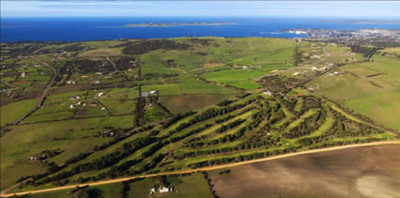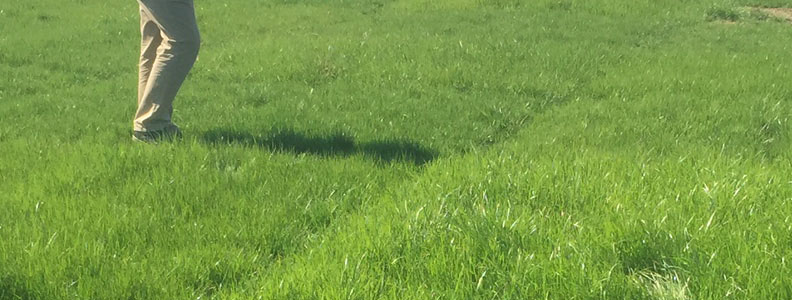
Change to golf is coming… or is it already here?
At the recent Queensland Golf Industry Forum, there was some interesting discussion regarding golf innovation and the need to cater for social/casual golfers in a non-threatening environment.
Such innovations have the potential to impact on course management in various ways, and could be seen as an “inconvenience” to established practices and routines. Or are they a great opportunity?
I recently had the chance to visit Port Lincoln, a renowned fishing town at the bottom of South Australia’s magnificent Eyre Peninsula. It gave me the chance to catch up with Andy Blacker, a great colleague who happens to share the same birth date and hairdresser as me! Andy has been a driving force as Superintendent at Thaxted Park Golf Club and Adelaide Shores, as well as serving as President of the SAGCSA for a number of years, before making the call to secure a lifestyle for his family and taking on the Super’s role at Port Lincoln Golf Club.
I only had an hour or so with Andy, but it was quickly apparent how good a job he was doing, with the course in great shape, and the members seemingly saluting as we drove past! We talked turf and lifestyle for a while, but the conversation quickly turned to what makes the course so appealing. Port Lincoln is like a lot of rural/regional courses, in that is pretty simple in terms of architectural features, but it is genuinely appealing to play.
It was great to see people enjoying the game and each other’s company in great surroundings. It was great to hear that the club was prospering as a result
Then like a couple of wise old owls, we began theorising it was the fact that in a community such as Port Lincoln, it filled a need by offering the chance to have a great golfing experience, an opportunity for social interaction, some good but not too strenuous exercise, and was really well suited to its market. It was relevant.
Why Change?
Golf is facing some challenges. Not that I needed to highlight the point, as we have been reading for the best part of a decade of the decline in participation and pending sense of doom and gloom around the world. We have heard (and in many cases know from personal experience) that issues such as time, cost, work/life balance, family commitments etc are put forward as reasons for the drop in numbers playing or retaining memberships with golf clubs around the globe.
It’s as if the game of golf is losing its place, maybe even relevance, in today’s world.
As we have dug deeper into the issue, there seems to be a new set of issues getting in the way of golf’s growth. We hear increasing feedback that the game is too difficult, and it that it is intimidating. This is coming from people who want to take up the game (the idea of strolling on some nice grass in a beautiful setting while hitting a ball occasionally still has some appeal), but unfortunately the experience is not matching the perception. And if you have a bad first experience at a restaurant, do you go back?
There are now some great programs being introduced by coaches, clubs, associations and governing bodies all over the world, and they are beginning to tailor programs to appeal to women and children in particular.
But when they get there, what do we have to offer? Do our courses and facilities make them feel comfortable?
I know my boys enjoyed trying golf as part of the physical education program early in secondary school, where they tried to hit a pitching wedge into a hoop, bucket, or some proportionally more generous target than a 4.25 inch (sorry, 108mm) hole! It was simple and quick……you either hit or miss, then had another go. In a 30 minute lesson, they could have scored plenty of “goals”, and easily kept a competitive tab with their mates.
But as soon as we got to the course, it all got way more complicated. Different clubs, lots of shots to remember in order to score, RULES, and a long way to get to a frustratingly small target. Three holes and we were done!
I am sure we can all relate to watching once or twice a year (life?) golfers battling nerves, embarrassment and ultimately sheer frustration trying to mix it with corporate buddies, or worse, while networking with people they have only just met. What is their impression of your course?………too hard, if they even noticed it!
Many new golfers find the prospect of having to play with a “good” golfer on the full length course amongst an experienced field intimidating and embarrassing. They would prefer to practice on their own at the range or practice green, or play for a short length of time, away from scrutinising eyes. Do we cater for them?
The 2013 National Golf Participation Report (Golf Australia, GMA) concludes with some points from The Future of Australian Sport report and Golf’s 2020 Vision report that provide some great insight to the prospective golf market into the future. What do we need to do to cater for these future needs?
A quick scroll through numerous surveys or questionnaires on the question of why people play golf reveals that for many, it is more about social engagement, physical exercise, relaxing, and enjoying the natural surroundings, than the challenge of course X.
The more we consider ways that we can get more people satisfying these needs, as well as overcoming the perceived barriers to playing the game, the better we will all be. To do this, some things may need to change.
Change is Inevitable
There are now numerous examples of golf innovation. We read or watch on social media ‘big hole golf‘, or ‘foot golf‘, most likely with the reaction that they are just quirky ideas that will come and go.
But the reality (and my own market research with my kids!) suggests these ideas have great appeal. Maybe not for the traditional golfer, but for a potentially whole new market, some of whom one day may become the traditional golfer.
Society is now blessed with convenience in almost everything we do. Even with our leisure time, we want something that is convenient, quick, easy to learn and cheap. Kids today are used to instant gratification (ever been around the house when the internet goes down?!), so when they play something, they want a result quickly, then have another go.
Look at what 20/20 cricket has done as a “feeder” for the game overall. It is entertaining, colourful, loud and relatively quick to get a result……perfect! It offers something for the whole family, and it has quickly dominated prime time scheduling because people are voting with their feet. Without it, where would cricket be even in the traditional form of the game?
Regardless of whether foot golf, big hole golf or some “other” golf are the answer, it is clear that something about the game will need to change to have the wide appeal that some other sports can offer to keep attracting new golfers.
What can we do?
How does this discussion impact Course Superintendents and their teams? In the hectic daily management of a golf course, we can be very reliant on routines and systems to get things done in a certain order, by a certain time, or on a certain day.
It is inevitable for most of us that we will need to find ways to accommodate these new demands, and still satisfy the expectations of existing, traditional golfers. But to me, this is one of the most exciting challenges as it presents opportunities to help the game and our clubs to grow, and to do some things differently. We can be part of the solution.
Embrace the change
Twenty years ago, who would have thought you could go to a lawn bowls club in a pair of board shorts and barefoot, and be welcomed to have a roll while listening to music playing across the greens and having a beer? But in 2015, it’s happening, and bowls clubs have embraced the change. Because they had to. They were losing relevance and appeal in the community. Now (as my 18 year old will attest), they host a great night out that is fun, cheap, relaxed, quick and still satisfies that competitive streak if you have one.
Golf clubs have the opportunity to do the same, but it WILL mean some changes to the way we manage our courses. We need to be prepared to embrace the change, as people playing or enjoying our golf courses in any form is (in most cases) ultimately good for business, and good for job security.
- Do we need to think about how we can effectively prepare 3 or 6 holes on the back nine to host a small corporate group running a breakfast workshop, or for office workers wanting a quick fix before the 9-5 grind, while still preparing the front nine for regular play?
- Can we suggest practical, manageable options for forward tee locations that will appeal to people taking up the game and not needing (or wanting) the challenge of the full length course?
- Can these be implemented on just 3 or 6 holes to cater for new players to the game wanting to avoid the experienced fields?
- What about the best way to accommodate large hole golf in the afternoon, without disrupting play for morning members or guests?
- Or the best location for foot golf holes that won’t see vegetation or irrigation infrastructure damaged by overzealous kickers?
- Could there be an economical way to build an additional putting green to allow coaching clinics to be conducted without restricting access to practice facilities for members and guests?
- This is something we have done recently at Glenelg. Due to the great work being done by the Golf Operations team in attracting kids and women to coaching clinics, there were times the practice green was overrun and not available to our members and guests. Or they simply felt intimidated when there was a group of young single figure handicappers strutting their stuff, and all they wanted to do was anonymously work on their wavering technique on three footers!
- Do we have the space and opportunity to build a simple, cheap pitch and putt area for kids to enjoy some fun with the parents for an hour? These types of areas can be a great asset for the club, and a saviour for parents during school holidays!
Watch the trends and get on the front foot
- Offer suggestions as to how to accommodate new opportunities. We are best placed to understand how they may impact on the courses we manage, so why not be part of the process that sees them implemented successfully, rather than amid frustration and angst.
- Planning new work procedures or perhaps necessary investment could ultimately make the process of change far more enjoyable for all parties. Make you and your team a valuable part of the solution.
- If you can see difficulties in accommodating for some of these ideas because of a lack of staff numbers or other resources, put that forward in a constructive manner and offer a solution at the same time.
Think about the new player
I have a firm belief that one of the most subtly enjoyable aspects of the game of golf is the offer of shot variety. When a golfer has a choice of landing zones from the tee or shots that can be played around the green, there is a sense of fun, because the golfer is forced to think and imagine what the ball will do.
Around the green in particular, there can be opportunities to alter mowing lines or heights to promote a greater variety of shot selection, or even help to speed up play. Many golfers welcome the chance to putt from off the green in preference to embarrassing themselves by circumnavigating an entire green with a series of shanks, so giving them that option can make the game much more enjoyable.
In some cases, this may mean working closely with a course architect to ensure the strategy of the course is not compromised, but increasingly I think we are all on the same page and recognise the need to create golf courses that offer a great golfing experience for as many as possible, rather than an exhausting test of muscle for the enjoyment of a few.
Summary
I love the traditions of the game of golf. Give me the history of The Open on a windy links any day of the week, with the tension, drama and emotion of the sport at the elite level on the great courses.
But I also think of what golf represents for me now. The thought of where I am going to play is not always as tempting as the thought of who I am going to play with.
For me, the ultimate group would be a five ball with my family late into an Adelaide autumn afternoon. The reality is it would be a three ball, with the girls having cut a deal to go shopping and meet us after for coffee or wine instead, and it would only be 9 holes, because that’s enough for 18-20 year old novices!
Where? Doesn’t matter. It would be the company that would make the day, as long as it was somewhere fun to play and created an experience to remember.
And that’s what we should be looking forward to creating; opportunities for people to experience and enjoy our courses and clubs, even if it looks a bit different to the game we grew up with.
We may need to embrace different forms of the game or uses for our courses to help sustain our clubs. In the short term, shorter forms of forms of the game can be easily adopted to appeal to people who want to progress from starter lessons to playing the game.
But there is no doubt marketers of the game will have to come up with some innovative, left field ideas, and course management will be impacted from time to time. We will be forced to think creatively about how we meet as many needs as possible, but I think we should look forward to the challenge.
Change can be good











Hi Daryl
Great article on “Change to golf is coming… or is it already here”? You have highlighted so many of the important points that are challenging the game and the sustainability of the golf club. Well done! You as a very good golfer, course superintendent, communicator, consultant and agronomist would make a perfect addition to the board of Golf Australia!
John Neylan